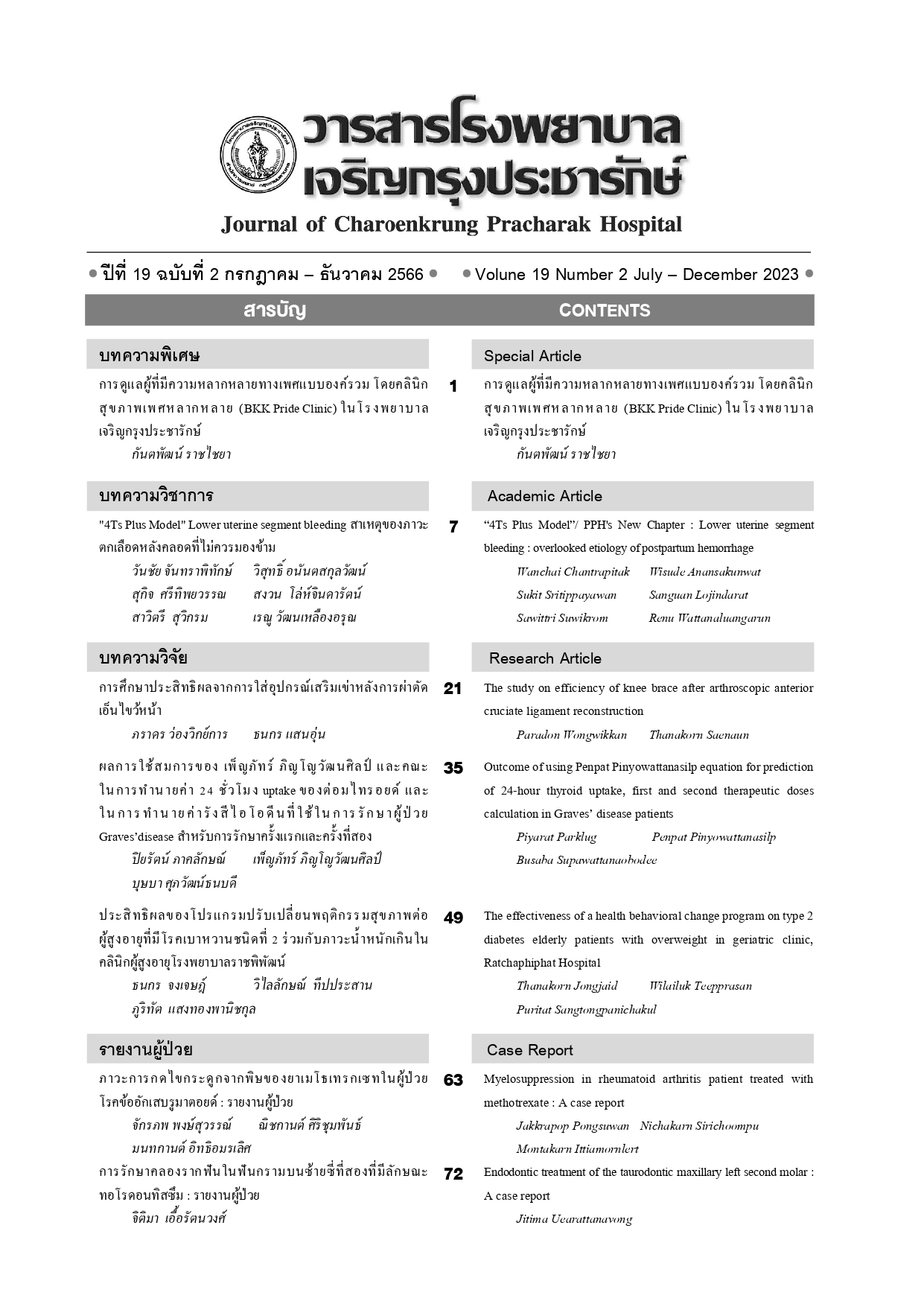การศึกษาประสิทธิผลจากการใส่อุปกรณ์เสริมเข่าหลังการผ่าตัดเอ็นไขว้หน้า
Main Article Content
บทคัดย่อ
วัตถุประสงค์ : เพื่อเปรียบเทียบความแข็งแรงของกล้ามเนื้อขา และพิสัยมุมการเคลื่อนไหวข้อเข่าระหว่างกลุ่มที่ใส่และไม่ใส่อุปกรณ์เสริมข้อเข่าหลังการผ่าตัดเอ็นไขว้หน้า
วิธีดำเนินการวิจัย : ศึกษาเชิงพรรณนาแบบย้อนหลัง ในผู้ป่วยที่ผ่าตัดส่องกล้องเอ็นไขว้หน้า ณ โรงพยาบาลเจริญกรุงประชารักษ์และเข้าร่วมโปรแกรมการฟื้นฟูร่างกายอย่างต่อเนื่องเป็นเวลา 3 เดือน ตั้งแต่วันที่ 1 ตุลาคม พ.ศ. 2558 - 31 กันยายน พ.ศ. 2563 โดยเก็บข้อมูลขั้นพื้นฐาน ผลการทดสอบ
ความแข็งแรงของกล้ามเนื้อขา พิสัยมุมการเคลื่อนไหวของข้อเข่าหลังการผ่าตัด 3 เดือน วิเคราะห์ข้อมูลโดยใช้สถิติเชิงพรรณนานำเสนอ ร้อยละ ค่าเฉลี่ย ค่าเบี่ยงเบนมาตรฐาน ค่ามัธยฐาน และพิสัยควอไทล์ และสถิติเชิงวิเคราะห์ คือ independent t-test หรือ Mann-whitney U-test statistic chi-square test และ Fisher exact test
ผลการวิจัย : ผู้ป่วยทั้งหมด 46 ราย เป็นเพศชาย 36 ราย คิดเป็นร้อยละ 78.3 และเพศหญิง 10 ราย คิดเป็นร้อยละ 21.7 แบ่งเป็นกลุ่มละ 23 รายที่ใส่และไม่ใส่อุปกรณ์เสริมข้อเข่า พบว่า มัธยฐานและพิสัยควอไทล์มุมการเคลื่อนไหวท่าเหยียดเข่าของ (median(IQR) ใส่ 1(0,5), ไม่ใส่ 1(0,3) องศา) ท่างอเข่า (median(IQR) ใส่ 130(125,132), ไม่ใส่ 131(129,135) องศา) ค่าเฉลี่ยความแข็งแรงของกล้ามเนื้อต้นขาด้านหน้า ใส่ 105.16±29.15 และ ไม่ใส่ 106.37±45.75 นิวตัน-เมตร ด้านหลัง ใส่ 63.86±16.21 และ ไม่ใส่ 60.51±21.99 นิวตัน-เมตร และอัตราส่วนความแข็งแรงของต้นขาด้านหน้าและต้นขาด้านหลัง ใส่ 63.49±17.78 เปอร์เซ็นต์ และ ไม่ใส่ 60.26±16.68 เปอร์เซ็นต์ ระหว่างกลุ่มใส่อุปกรณ์เสริมเข่าและกลุ่มที่ไม่ใส่อุปกรณ์เสริมเข่าไม่มีความแตกต่างกันในทางสถิติ
สรุป : การใส่หรือไม่ใส่อุปกรณ์เสริมข้อเข่าหลังการผ่าตัดเอ็นไขว้หน้าไม่ส่งผลต่อพิสัยมุมการเคลื่อนไหวและความแข็งแรงของกล้ามเนื้อขา โดยทั้งสองกลุ่มมีผลการรักษาที่ไม่มีความแตกต่างกัน ซึ่งสามารถนำไปประยุกต์ใช้และให้คำแนะนำในการดูแลผู้ป่วยหลังจากการผ่าตัดได้ แต่ควรคำนึงถึงปัจจัยภายนอกร่วมด้วย เช่น อายุ เพศ โรคประจำตัว การรักษา ความแตกต่างของอุปกรณ์ การใช้งานอุปกรณ์ และการปฏิบัติตัวตามคำแนะนำร่วมด้วย
Article Details

อนุญาตภายใต้เงื่อนไข Creative Commons Attribution-NonCommercial-NoDerivatives 4.0 International License.
เอกสารอ้างอิง
Kulkamthom N, Arkasihayuth A, Charakorn K, Chaimut M, Reeboonlap N. The study of anterior cruciate ligament footprint in Thai population: a human cadaveric study. J Med Assoc Thai 2012;95 Suppl 10:S167-72.
Andrews JR, Harrelson GL, Wilk KE. Physical rehabilitation of the injured athlete. 4thed. Philadelphia PA: Elsevier Health Sciences; 2012.
ธวัชชัย เทียมกลาง, ปกรณ์ นาระคล, เสริมศักดิ์ สุมานนท์. การเปรียบเทียบผลการรักษาของวิธีใช้เส้นเอ็นสะบ้ากับวิธีใช้เส้นเอ็นแฮมสตริงสองมัดในการผ่าตัดสร้างเส้นเอ็นไขว้หน้าข้อเข่าผ่านกล้องส่องข้อ. ศรีนคริทร์เวชสาร 2553;25:208-14.
Shelbourne KD, Nitz P. Accelerated rehabilitation after anterior cruciate ligament reconstruction. Am J Sports Med 1990;18:292-99.
Wilk KE, Andrews JR. Current concepts in the treatment of anterior cruciate ligament disruption. J Orthop Sports Phys Ther 1992;15:279-93.
Beaudreuil J, Bendaya S, Faucher M, Coudeyre E, Ribinik P, Revel M, et al. Clinical practice guidelines for rest orthosis, knee sleeves, and unloading knee braces in knee osteoarthritis. Joint Bone Spine 2009;76:629-36.
Bordes P, Laboute E, Bertolotti A, Dalmay JF, Puig P, Trouve P, et al. No beneficial effect of bracing after anterior cruciate ligament reconstruction in a cohort of 969 athletes followed in rehabilitation. Ann Phys Rehabil Med 2017;60:230-6.
Kruse LM, Gray B, Wright RW. Rehabilitation after anterior cruciate ligament reconstruction: a systematic review. J Bone Joint Surg Am 2012;94:1737-48.
Masini BD, Owens BD. Current recommendations for anterior cruciate ligament bracing: when to use. Phys Sportsmed 2013;41:35-9.
Lysholm J, Gillquist J. Evaluation of knee ligament surgery results with special emphasis on use of a scoring scale. Am J Sports Med 1982;10:150-4.
Tegner Y, Lysholm J. Rating systems in the evaluation of knee ligament injuries. Clin Orthop Relat Res 1985;198:43-9.
Birmingham TB, Bryant DM, Giffin JR, Litchfield RB, Kramer JF, Donner A, et al. A randomized controlled trial comparing the effectiveness of functional knee brace and neoprene sleeve use after anterior cruciate ligament reconstruction. Am J Sports Med 2008;36:648-55.
Snyder-Mackler L, Fitzgerald GK, Bartolozzi AR 3rd, Ciccotti MG. The relationship between passive joint laxity and functional outcome after anterior cruciate ligament injury. Am J Sports Med 1997;25:191-5.
Lewek M, Rudolph K, Axe M, Snyder-Mackler L. The effect of insufficient quadriceps strength on gait after anterior cruciate ligament reconstruction. Clin Biomech (Bristol, Avon) 2002;17 :56-63.
Alkjær T, Henriksen M, Simonsen EB. Different knee joint loading patterns in ACL deficient copers and non-copers during walking. Knee Surg Sports Traumatol Arthrosc 2011;19:615-21.
Oberländer KD, Brüggemann GP, Höher J, Karamanidis K. Altered landing mechanics in ACL-reconstructed patients. Med Sci Sports Exerc 2013;45:506-13.
Roewer BD, Di Stasi SL, Snyder-Mackler L. Quadriceps strength and weight acceptance strategies continue to improve two years after anterior cruciate ligament reconstruction. J Biomech 2011;44:1948-53.
Torry MR, Myers C, Shelburne KB, Peterson D, Giphart JE, Pennington WW, et al. Relationship of knee shear force and extensor moment on knee translations in females performing drop landings: a biplane fluoroscopy study. Clin Biomech (Bristol, Avon) 2011;26:1019-24.
Zabala ME, Favre J, Scanlan SF, Donahue J, Andriacchi TP. Three-dimensional knee moments of ACL reconstructed and control subjects during gait, stair ascent, and stair descent. J Biomech 2013;46:515-20.
Hislop HJ, Perrine JJ. The isokinetic concept of exercise. Phys Ther 1967;47:114-7.
Kvist J. Rehabilitation following anterior cruciate ligament injury: current recommendations for sports participation. Sports Med 2004;34:269-80.
Centers for Disease Control and Prevention. Public Use Dataset for Normal Joint Range of Motion; 2010.
Bordes P, Laboute E, Bertolotti A, Dalmay JF, Puig P, Trouve P, et al. No beneficial effect of bracing after anterior cruciate ligament reconstruction in a cohort of 969 athletes followed in rehabilitation. Ann Phys Rehabil Med 2017;60:230-6.
Zainal Abidin NA, Shafie SNS, Azaman A, Ramlee MH. Knee orthosis for anterior cruciate ligament injuries-kinematics and comfortability study. In Journal of Physics: Conference Series 2021;2071:012016.
Czaplicki A, Jarocka M, Walawski J. Isokinetic identification of knee joint torques before and after anterior cruciate ligament reconstruction. PLoS One 2015;10:e0144283.
Harilainen A, Sandelin J. Post-operative use of knee brace in bone-tendon-bone patellar tendon anterior cruciate ligament reconstruction: 5-year follow-up results of a randomized prospective study. Scand J Med Sci Sports 2006;16:14-8.
Yang XG, Feng JT, He X, Wang F, Hu YC. The effect of knee bracing on the knee function and stability following anterior cruciate ligament reconstruction: a systematic review and meta-analysis of randomized controlled trials. Orthopaedics & Traumatology: Surgery & Research 2019;105:1107-14.
Marois B, Tan XW, Pauyo T, Dodin P, Ballaz L, Nault M L. Can a knee brace prevent acl reinjury: a systematic review. International Journal of Environmental Research and Public Health 2021;18,7611.


